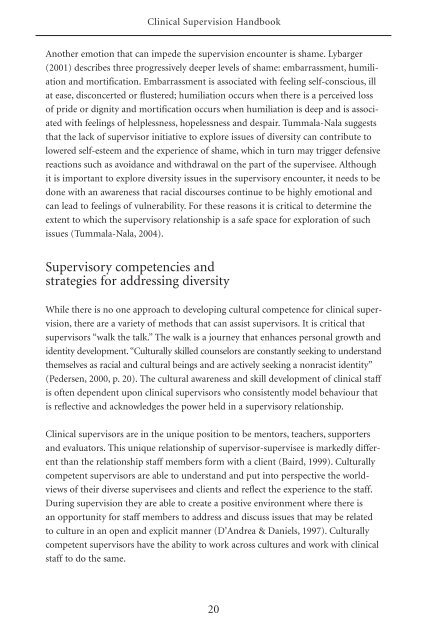Clinical Supervision Handbook - CAMH Knowledge Exchange ..
You also want an ePaper? Increase the reach of your titles
YUMPU automatically turns print PDFs into web optimized ePapers that Google loves.
<strong>Clinical</strong> <strong>Supervision</strong> <strong>Handbook</strong><br />
Another emotion that can impede the supervision encounter is shame. Lybarger<br />
(2001) describes three progressively deeper levels of shame: embarrassment, humiliation<br />
and mortification. Embarrassment is associated with feeling self-conscious, ill<br />
at ease, disconcerted or flustered; humiliation occurs when there is a perceived loss<br />
of pride or dignity and mortification occurs when humiliation is deep and is associated<br />
with feelings of helplessness, hopelessness and despair. Tummala-Nala suggests<br />
that the lack of supervisor initiative to explore issues of diversity can contribute to<br />
lowered self-esteem and the experience of shame, which in turn may trigger defensive<br />
reactions such as avoidance and withdrawal on the part of the supervisee. Although<br />
it is important to explore diversity issues in the supervisory encounter, it needs to be<br />
done with an awareness that racial discourses continue to be highly emotional and<br />
can lead to feelings of vulnerability. For these reasons it is critical to determine the<br />
extent to which the supervisory relationship is a safe space for exploration of such<br />
issues (Tummala-Nala, 2004).<br />
Supervisory competencies and<br />
strategies for addressing diversity<br />
While there is no one approach to developing cultural competence for clinical supervision,<br />
there are a variety of methods that can assist supervisors. It is critical that<br />
supervisors “walk the talk.” The walk is a journey that enhances personal growth and<br />
identity development. “Culturally skilled counselors are constantly seeking to understand<br />
themselves as racial and cultural beings and are actively seeking a nonracist identity”<br />
(Pedersen, 2000, p. 20). The cultural awareness and skill development of clinical staff<br />
is often dependent upon clinical supervisors who consistently model behaviour that<br />
is reflective and acknowledges the power held in a supervisory relationship.<br />
<strong>Clinical</strong> supervisors are in the unique position to be mentors, teachers, supporters<br />
and evaluators. This unique relationship of supervisor-supervisee is markedly different<br />
than the relationship staff members form with a client (Baird, 1999). Culturally<br />
competent supervisors are able to understand and put into perspective the worldviews<br />
of their diverse supervisees and clients and reflect the experience to the staff.<br />
During supervision they are able to create a positive environment where there is<br />
an opportunity for staff members to address and discuss issues that may be related<br />
to culture in an open and explicit manner (D’Andrea & Daniels, 1997). Culturally<br />
competent supervisors have the ability to work across cultures and work with clinical<br />
staff to do the same.<br />
20


